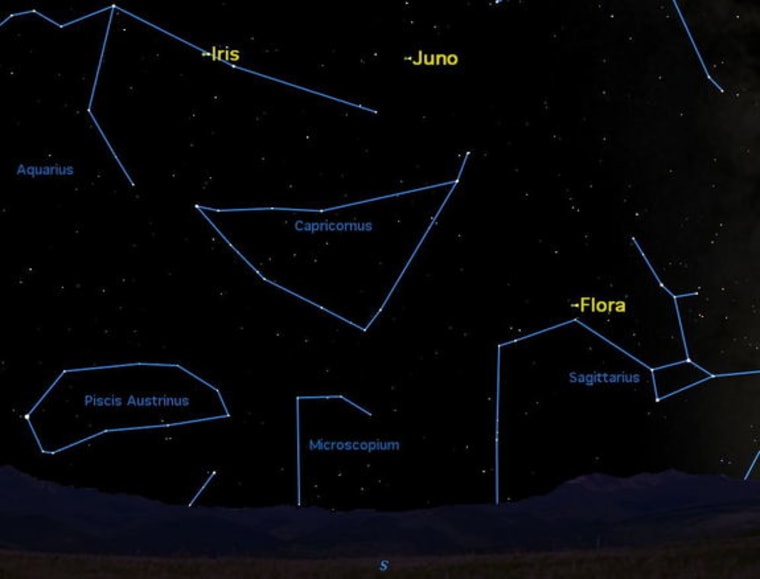Have you ever seen an asteroid? These space rocks, though small in size, are very numerous, but very few amateur astronomers have ever seen one. The next couple of weeks give stargazers an opportunity to view three asteroids in one night: Flora, Juno, and Iris.
The asteroids Juno, Flora and Iris were among the first eight space rocks ever to be discovered. Juno was the third asteroid discovered, in 1804, very soon after Ceres — the largest asteroid — in 1801 and Pallas in 1802. It was discovered by German astronomer Karl Ludwig Harding, and named after Juno, the highest of the Roman goddesses.
At present Juno is located in the western part of the constellation Aquarius, and is about magnitude +8.6 on the scale used by astronomers to measure brightness of space objects. (The lower the number, the brighter the object, with negative numbers denoting exceptional brightness.) [Amazing August Stargazing Events (Gallery)]
Juno is too faint to be seen with the unaided eye, but can be easily seen in binoculars or a small telescope. In amateur telescopes it is too small to look any different than a star, hence the name "asteroid" meaning "star-like."
The first asteroids were discovered quite by accident. In 1846, British astronomer John Russell Hind decided to change that by beginning a systematic effort to search for asteroids using the newly published Berlin star maps. He plotted objects along the ecliptic, adding stars that were too faint to be on the maps, and looking for any star that seemed to move. He was rewarded the next year by his discovery of two new asteroids, Iris on Aug. 13 and Flora on Oct. 18.
Iris is named after the Greek goddess of the rainbow and Flora after the Roman goddess of flowers. Juno is the largest of the three, 145 miles (233 kilometers) in diameter, and Flora the smallest at 80 miles (128 km), with Iris in between at 125 miles (200 km). As you can see, they are all quite tiny bodies. The asteroid Juno has been photographed by the Hooker Telescope at Mount Wilson, and is a rough potato shape with a very large crater on its surface.
Currently, Iris is in central Aquarius at magnitude 7.6, making it the brightest of the three, and Flora is in Sagittarius at magnitude 8.6. Iris is just south of the globular cluster Messier 2, Juno just north of Messiers 72 and 73, and Flora just west of globular cluster Messier 75.
If you want to replicate the methods used by these early 19th century astronomers, you could plot the "stars" in the neighborhoods indicated on successive nights, and then look for the ones that move. Or you could use the more modern approach of printing finder charts using a modern planetarium program on your computer. All three are moving slowly westward, from left to right for observers in the Northern Hemisphere.
It's really quite remarkable that we can see these tiny chunks of rock, farther away than Mars, with ordinary binoculars. Don’t miss this chance.
Editor's Note: If you snap an amazing picture of these asteroids or any night sky view and you'd like to share it for a possible story or image gallery, send photos and comments, including your name and viewing location to Managing Editor Tariq Malik at spacephotos@space.com.
This article was provided to Space.com byStarry Night Education, the leader in space science curriculum solutions. Follow Starry Night on Twitter@StarryNightEdu. Original article on Space.com.
- Night Sky: Visible Planets, Moon Phases & Events, August 2013
- Look For The Perseids In The August Night Skies | Video
- Asteroid Basics: A Space Rock Quiz
